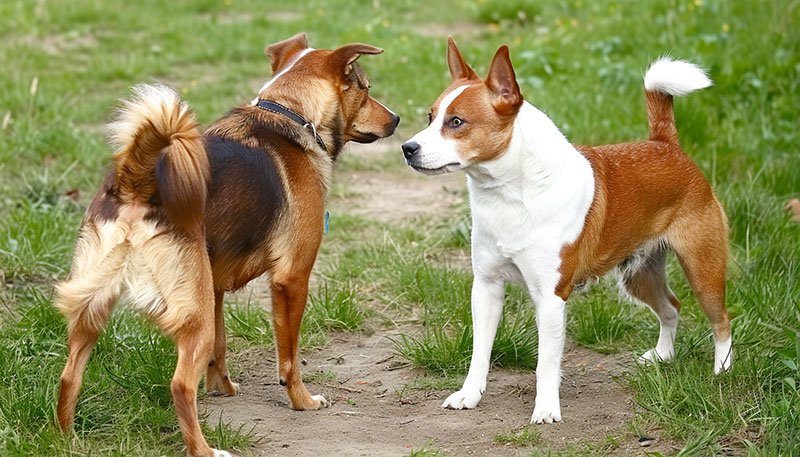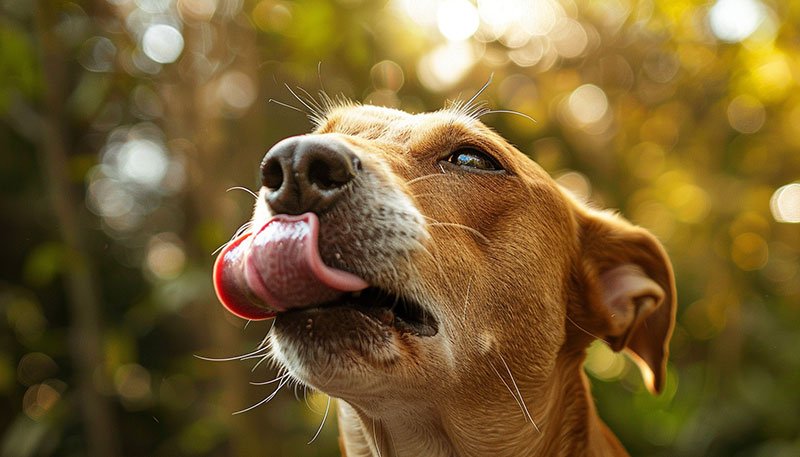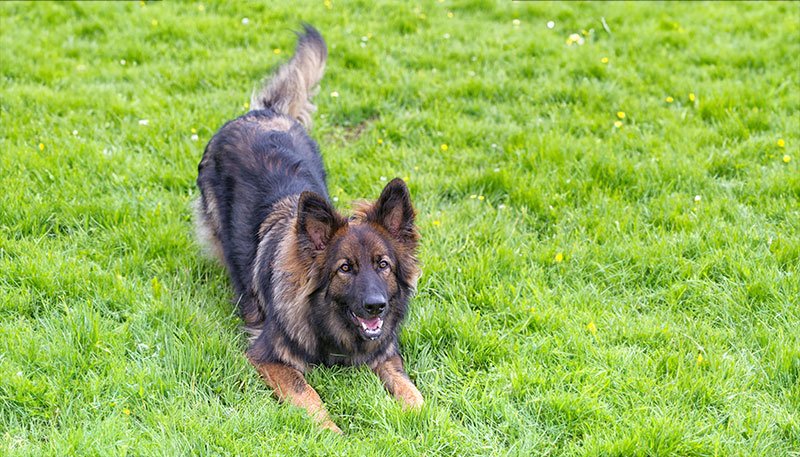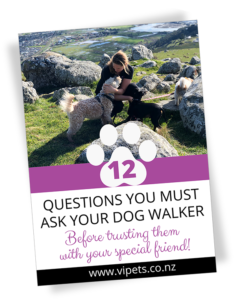Ever wonder what’s going on in your dog’s mind and thought; “if only they could speak to us and tell us how they are feeling?” Dogs, like people, have their own way of expressing emotions. Knowing how to read these signals can help you understand their needs, moods, and well-being.
Because dogs don’t have a spoken language, they communicate with each other through their body language. By learning to recognize and interpret these signals, you can better understand your dog’s emotional state and respond appropriately.
The Tail
The tail is often the first thing we notice about a dog’s body language. It can be a powerful indicator of their emotional state. While many of us interpret a wagging tail as a sign of happiness, it’s not always that straightforward.
Let’s break down the most familiar tail signals to understand what your dog might be feeling.
- Wagging: A wagging tail can mean many things, depending on its speed and position. A slow wag might indicate hesitation or cautiousness, while a fast wag usually shows excitement. The higher the tail, the more confident the dog; a low wag might suggest submission or insecurity.
- Tucked Tail: A tail tucked between the legs is a classic sign of fear or anxiety.
- Stiff, High Tail: This could mean the dog is feeling confident or aggressive.

Ears
A dog’s ears are incredibly expressive and can tell you a lot about their mood and intentions. By paying attention to the position and movement of your dog’s ears, you can gain insights into whether they are feeling alert, relaxed, anxious, or scared.
Here’s how to decode those ear signals.
- Erect Ears: When a dog’s ears are perked up and facing forward, they’re typically alert and focused.
- Flattened Ears: Ears pulled back against the head can indicate fear, submission, or stress.
- Neutral Ears: Ears in a relaxed position generally suggest that your dog is calm and comfortable.

Eyes
Just like with humans, a dog’s eyes can reveal a lot about their emotions. From soft, relaxed eyes to hard stares and whale eyes, the subtleties in your dog’s gaze can help you understand what they are trying to communicate.
Let’s explore what different eye expressions mean.
- Soft Eyes: Relaxed, blinking eyes show a calm and happy dog.
- Hard Stare: A direct, unblinking stare can be a sign of dominance or a potential threat.
- Whale Eye: When you can see the whites of their eyes, your dog might be feeling anxious or threatened.

Mouth
A dog’s mouth isn’t just for barking, eating, or panting; it’s also a key player in their body language. From relaxed mouths and panting to showing teeth and licking lips, the movements and positions of a dog’s mouth can provide significant clues about their emotional state.
Let’s dive into what different mouth signals indicate.
- Relaxed Mouth: A slightly open mouth, almost as if your dog is smiling, indicates relaxation and happiness.
- Panting: Normal after exercise or in hot weather, but excessive panting when they are not hot could mean stress or discomfort.
- Lips Pulled Back: If a dog’s lips are pulled back, showing teeth but without growling, it might be a sign of fear or submission.
- Licking Lips: Frequent licking of the lips when not eating can be a sign of anxiety or appeasement. They can do this to show other dogs they are not a threat.
- Yawning: Yawning when not tired can be a signal of stress, excitement, or confusion.

Posture
The overall posture of your dog can give you a comprehensive view of their emotional state. Whether they’re playfully bowing, standing stiffly, or rolling over, the way they carry their body can communicate a wealth of information.
Here’s a closer look at the various postures and what they mean.
- Play Bow: Front legs stretched out, chest close to the ground, and hind end up—this is a classic invitation to play.
- Stiff Body: A rigid, tense body can indicate aggression or fear.
- Rolling Over: This could be a sign of submission, or if they’re playful, it might just be an invitation for a belly rub.
- Freezing: Suddenly stopping all movement can indicate fear or caution.
- Raised Hackles: The fur along the back standing up usually means arousal, which could be from fear, excitement, or aggression.
- Shaking Off: Like shaking off water, this can indicate a dog is trying to relieve stress.

Vocalisations
Dogs use a range of vocalizations to express themselves, and each sound can carry different meanings. From barking and whining to growling and beyond, understanding these sounds in context can help you better interpret your dog’s needs and feelings.
Let’s break down the different types of vocalizations and their meanings.
- Barking: The pitch, frequency, and volume of barking can signify different emotions—low-pitched barks often indicate a warning or threat, while higher-pitched barks might show excitement.
- Whining: Often a sign of anxiety, submission, or a request for attention.
- Growling: Can indicate fear, possession, or aggression. Context is key here.
Paws
A dog’s paws are often overlooked in body language discussions, but they can be quite telling. From lifting a paw to scratching or digging, the way a dog uses their paws can indicate various emotions and intentions.
Here’s what different paw behaviors can tell you about your dog.
- Paw Lift: When a dog lifts a paw, it often means they are uncertain or submissive. Sometimes, it can also mean they’re about to take a step forward cautiously.
- Scratching or Digging: This can be a sign of anxiety, boredom, or just plain old instinctual behaviour.
- Pawing at You: A gentle paw tap can mean your dog is seeking attention or indicating they want something.
Other Behaviors: Subtle Signs
In addition to the more obvious signals, dogs exhibit a variety of subtle behaviors that can communicate their feelings. As we’ve mentioned, these can include yawning when they’re not tired, licking lips when they’re not eating, shaking off when they’re not wet, and more. Understanding these smaller cues can provide a fuller picture of your dog’s emotional state.
Let’s explore more of these subtle signals.
- Sniffing the Ground: Often a displacement behaviour when a dog is unsure or stressed.
- Head Tilting: Indicates curiosity or trying to understand something better.
- Play Bow: Front legs stretched out, chest close to the ground, and hind end up—this is a classic invitation to play.
- Stiff Body: A rigid, tense body can indicate aggression or fear.
- Rolling Over: This could be a sign of submission, or if they’re playful, it might just be an invitation for a belly rub.
- Freezing: Suddenly stopping all movement can indicate fear or caution.
- Raised Hackles: The fur along the back standing up usually means arousal, which could be from fear, excitement, or aggression.
- Shaking Off: Like shaking off water, this can indicate a dog is trying to relieve stress.
How to Spot These Signals
- Observe the Whole Dog: Instead of focusing on just one part of the body, look at the dog’s overall posture and movement.
- Consider the Context: The same signal can mean different things in different situations. A wagging tail in a familiar park might mean excitement, while the same wag in a vet’s office could be a sign of nervousness.
- Watch for Combinations: Often, dogs will use multiple signals to convey how they’re feeling. For example, a stiff body with a hard stare and growling is a clear sign to back off.
Understanding your dog’s body language can help you respond appropriately to their needs, avoid potential conflicts, and strengthen your bond. Remember that individual dogs may have unique ways of expressing themselves, so it’s essential to become familiar with your own dog’s specific communication style.
By being attentive to these signals, you can better gauge your dog’s emotional state and provide the support, space, or intervention they need to feel safe and comfortable in various situations.
Do you have anything to add?
Anything you feel we’ve missed? Help us make this article as comprehensive as possible by adding it in the comments below. We appreciate your input!







